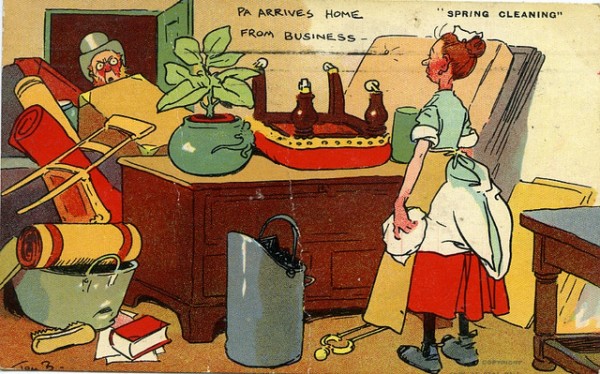
This is the time of year that many people throw open their windows and begin their yearly spring cleaning. Long ago, springtime cleaning had religious significance and coincided with holidays such as Passover and Easter. By the 19th century, spring cleaning had become more about practicality than piety. Particularly in places that suffered cold, wet winters, March and April were a perfect time for dusting because it was warm enough to open windows, but still too chilly for bugs to fly in the house. Ideally, the wind would help blow the dust out of the home instead of swirling it around the rooms.
The blame for a dusty shelf tends to fall on women’s shoulders because the home has traditionally been “her place” in society. Although the 1950s vision of June Cleaver has shifted and more women now participate in the labor force, women still tend to take on the bulk of the housework. Women employed outside the home have a “second shift” of cooking, cleaning, and childcare when they come home from work.
- Suzanne M. Bianchi, Liana C. Sayer, Melissa A. Milkie, John P. Robinson. 2012. “Housework: Who Did, Does, or Will Do It, and How Much Does it Matter?” Social Forces 91(1): 55-63.
- Suzanne M. Bianchi, Liana C. Sayer, Melissa A. Milkie, John P. Robinson. 2000. “Is Anyone Doing the Housework? Trends in the Gender Division of Household Labor.” Social Forces 79(1): 191-228.
- Arlie Hoschild with Anne Machung. 1989. The Second Shift. Penguin Books. New York, NY.
Women who work in more masculinized jobs tend to do more cooking and cleaning, and men with feminized professions engage in more “manly” tasks like yard work and auto repair to neutralize their gender-atypical occupations. Even in couples that are not comprised of a cis-man and a cis-woman, the gendered division of household labor persists. In couples consisting of trans*-men and cis-women, the women end up taking on the “Cinderella roles,” which they often link to personal preference rather than socialization or gender roles.
- Daniel Schneider. 2012. “Gender Deviance and Household Work: The Role of Occupation.” American Journal of Sociology 117(4): 1029-1072.
- Carla A. Pfeffer. 2010. “‘Women’s Work’? Women Partners of Transgender Men Doing Housework and Emotional Work.” Journal of Marriage and Family: 72(1): 165-183.
And what of the sociological significance of dust? A dusty book can show a lack of interest in the material, and the old adage “cleanliness is next to godliness” speaks to the moral implications of a dust-free, spotless home. Dust and dirt are out of place in the well-tended home, and their presence highlights a lack of control over the environment. Additionally, a lack of cleanliness has long served as a social indicator of moral disorder in Western Culture, acting as rallying point of social solidarity over what is socially acceptable.
- Gary Alan Fine and Tim Hallett. 2003. “Dust: A Study in Sociological Miniaturism.” The Sociological Quarterly 44(1): 1-15.
- Mary Douglas. 1966. Purity and Danger: An Analysis of Concepts of Pollution and Taboo. Routledge. United Kingdom.

Comments